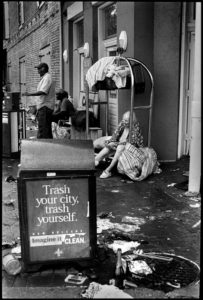Joshua Mann Pailet
Joshua Mann Pailet is recognized as both an art photographer and the owner/director of A Gallery of Fine Photography in New Orleans.

Courtesy of Joshua Mann Pailet
Imagine it Clean. Pailet, Joshua Mann (photographer)
Joshua Mann Pailet is recognized as both an art photographer and the owner/director of A Gallery of Fine Photography, which he founded in 1973. His photographs document life in New Orleans, including scenes of the French Quarter (his home neighborhood), musicians, Mardi Gras Indians, and the grand opening concerts and major events at the Louisiana Superdome.
Pailet offered a summary of his photographic work: “A roll of film per day for nearly forty years, 150,000 black-and-white negatives and 250,000 Kodachrome slides.” Among his list of subjects: “People, places, things, and once in a lifetime events; steam engines, performers, music, festivals, jazz funerals, the 1984 World’s Fair, streets, and characters of New York City, New Orleans, San Francisco, London, Paris, and Prague.”
Pailet was born in New Orleans in 1950, and raised in Baton Rouge, where he discovered a set of stereographic photographs in the Baton Rouge Public Library, an event he calls his “introduction to the world of photography.” Pailet attended Rice University in Houston, Texas, earning a bachelor’s degree in economics in 1972 and a bachelor’s degree in accounting in 1973. While studying at Rice, he acquired a Nikon camera and began making photographs, inspired by the photographer and teacher, Eve Sonneman, and he installed his first photography exhibition. He also met Houston’s renowned art collectors Dominique and John de Menil, who encouraged his interest in photography and purchased some of his early photographs.
After graduating, Pailet moved to New Orleans and opened A Gallery for Fine Photography. In 1975, he presented an exhibition of works by Ansel Adams as the gallery became an increasingly recognized French Quarter institution, one that attracted collectors as well tourists to see its exhibitions and photographic inventory. In 1976, Pailet traveled aboard the steam-powered American Freedom Train, a mobile museum that toured 48 states in the American Bicentennial year. As an invited artist, Pailet produced more than 15,000 photographs, including The 4449, American Freedom Train, and Long Live Freedom. A selection of these images was published in the book All Aboard, America (1976).
This project established the precedent for his working in extended documentary projects and built the foundation of his photographic archives. Pailet’s next series focused on the rebuilding of downtown New Orleans from 1980 to 1985, and the transformation of a riverfront warehouse site into the 1984 Louisiana World Exposition. He created more than 10,000 photographs, and published over 100 of these images in the book The World’s Fair, New Orleans (1987). An exhibition of these photographs was featured at the Ogden Museum of Southern Art to commemorate the twentieth anniversary of the World’s Fair.
When Hurricane Katrina struck New Orleans and the Gulf Coast in 2005, Pailet decided not to evacuate and remained in the French Quarter. After the storm passed, he documented its initial impact as well as its continuing aftermath in the weeks that followed as New Orleans flooded, reflected in photographs such as Crime Scene, Martha Stewart Never Slept Here, and The Edge of the Federal Flood (all 2005).
In 2010, the Polk Museum of Art, in Lakeland, Florida, organized a retrospective exhibition, Eye See America, thru the Lens of Joshua Mann Pailet, 1971–2010, accompanied by a full catalogue. Writing about Pailet’s photographs, curator Adam Justice noted that his works are “much more than photographs…they are clear observations into the substance that define the common core of our modern American existence,” and offered this conclusion: “Joshua Mann Pailet is first and foremost a fine arts photographer, but additionally he is a biographer of his experiences and, by way of cultural understanding, our own.” Among the photographs included in that exhibition were Man and Apes (1974), Rolling Stones, Mick Jagger and Billy Preston (1975), Superdome Sea (1975), Fortitude(1982), “Uncle” Lionel Batiste (1990), and Red Hawk, Mardi Gras Indian (2009).
His photographs are included in museum collections including the New Orleans Museum of Art, the Ogden Museum of Southern Art in New Orleans, and the Louisiana Arts and Science Center in Baton Rouge.
